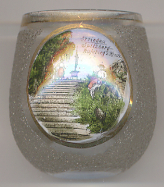

|
| POLSKA | POLAND |
| województwo: Dolnośląskie | voivodship: Lower Silesia |
| powiat: Świdnica | county: Świdnica |
Strzegom is a town in Świdnica County, Lower Silesian Voivodeship, in south-western Poland. It is the seat of the administrative district (gmina) Strzegom. It lies approximately 15 km north-west of Świdnica, and 52 km west of the regional capital Wrocław. The municipality has a population of about 16,400 (2016).
 Traces of settlement on the site during the Roman Empire period have been found. In the Middle Ages it was a fortified
settlement in Piast Poland, first mentioned in a deed issued by Pope Hadrian IV in 1155, confirming the boundaries of
the Wrocław diocese. About 1242 Strzegom received the privileges of a town by Anna of Bohemia,
widow of the Silesian duke Henryk II the Pious. In 1248 it fell to the Silesian Duchy of Legnica under Henry's son
Bolesław II the Bald, contested by his nephew Henryk IV Probus, who, imprisoned by his uncle at Jelcz,
finally had to renounce Strzegom in 1277. From the late 13th century the town belonged to the Duchy of Jawor and
Świdnica under Bolko I the Strict, and until 1392 was ruled by his descendants of the Silesian Piasts. Though they
initially withstood the vassalisation attempts by King John of Bohemia (Johann of Luxembourg),
the town subsequently shared the political fortunes of Silesia, and passed from Polish to Imperial Bohemian and in 1526 to
Austrian Habsburg sovereignty. During the Thirty Years' War (1618–1648) the city suffered almost complete destruction.
In 1742 Strzegom (in German: Striegau) became part of Prussia. On June 4, 1745 the Battle of Hohenfriedeberg
(Dobromierz), an important victory for King Friedrich II during the War of the Austrian Succession (Second Silesian War,
1744–1745), took place near the town. In the 19th century considerable industrial expansion took place, with granite
quarries playing a particularly important role in the town's economy. The first rail link to the town was opened in 1856.
As a result of the Potsdam Conference in 1945, Striegau became a part of Poland, and its German
inhabitants were expelled and the town was renamed Strzegom.
Traces of settlement on the site during the Roman Empire period have been found. In the Middle Ages it was a fortified
settlement in Piast Poland, first mentioned in a deed issued by Pope Hadrian IV in 1155, confirming the boundaries of
the Wrocław diocese. About 1242 Strzegom received the privileges of a town by Anna of Bohemia,
widow of the Silesian duke Henryk II the Pious. In 1248 it fell to the Silesian Duchy of Legnica under Henry's son
Bolesław II the Bald, contested by his nephew Henryk IV Probus, who, imprisoned by his uncle at Jelcz,
finally had to renounce Strzegom in 1277. From the late 13th century the town belonged to the Duchy of Jawor and
Świdnica under Bolko I the Strict, and until 1392 was ruled by his descendants of the Silesian Piasts. Though they
initially withstood the vassalisation attempts by King John of Bohemia (Johann of Luxembourg),
the town subsequently shared the political fortunes of Silesia, and passed from Polish to Imperial Bohemian and in 1526 to
Austrian Habsburg sovereignty. During the Thirty Years' War (1618–1648) the city suffered almost complete destruction.
In 1742 Strzegom (in German: Striegau) became part of Prussia. On June 4, 1745 the Battle of Hohenfriedeberg
(Dobromierz), an important victory for King Friedrich II during the War of the Austrian Succession (Second Silesian War,
1744–1745), took place near the town. In the 19th century considerable industrial expansion took place, with granite
quarries playing a particularly important role in the town's economy. The first rail link to the town was opened in 1856.
As a result of the Potsdam Conference in 1945, Striegau became a part of Poland, and its German
inhabitants were expelled and the town was renamed Strzegom.
The  Krzyżowa Góra (in German: Kreuzberg, previously Spitzberg) near Strzegom has
a height of 354 m. The picture on glass no. 2717 shows a view of the steps leading up to the crucifix on the
hills's summit, commemorating the soldiers, both Prussian and Austrian, who had died in the battle of 1745. The original
wooden crucifix was destroyed in in 1800 by a storm and again in 1819 by lightning. In 1840 a public collection raised money
for the creation of an iron crucifix, as well as a granite staircase of 100 steps leading up to the monument.
Krzyżowa Góra (in German: Kreuzberg, previously Spitzberg) near Strzegom has
a height of 354 m. The picture on glass no. 2717 shows a view of the steps leading up to the crucifix on the
hills's summit, commemorating the soldiers, both Prussian and Austrian, who had died in the battle of 1745. The original
wooden crucifix was destroyed in in 1800 by a storm and again in 1819 by lightning. In 1840 a public collection raised money
for the creation of an iron crucifix, as well as a granite staircase of 100 steps leading up to the monument.
[https://de.wikipedia.org/wiki/Strzegom, http://en.wikipedia.org/wiki/Strzegom, http://www.grenzgebiete.net/kultur/denkmaler/kreuzberg-bei-striegau-krzyzowa-gora/,
http://wroclaw.hydral.com.pl/27588,obiekt.html]
![[scale]](lineal.jpg)